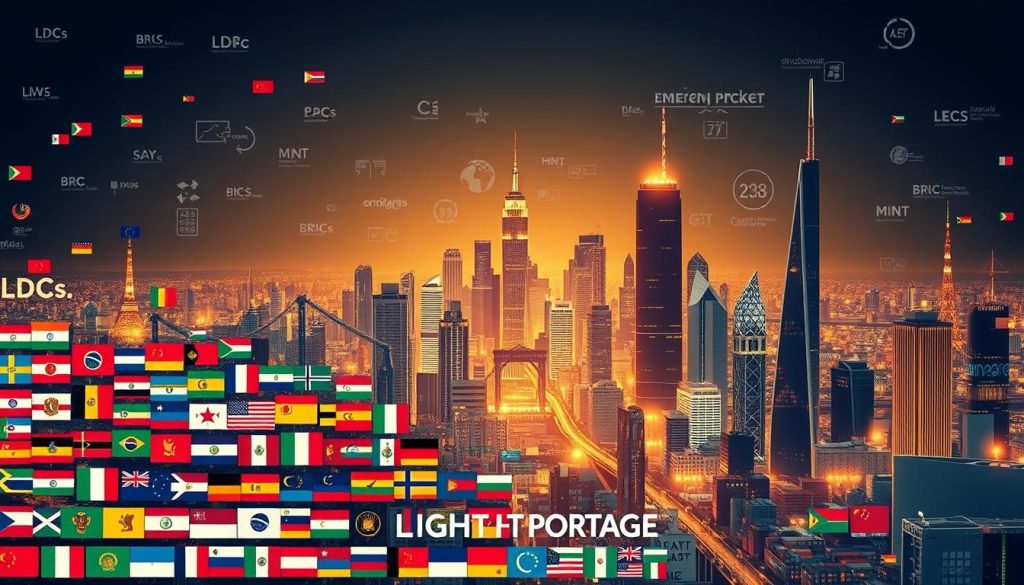We welcome you to a compact guide that turns complexity into clear steps. In Paris and beyond, many professionals face the same question: how do you move into new countries with confidence?
One team I advised started with a simple test in India. They scanned local demand, matched it to their core skills, and adjusted contracts before scaling. That small pilot revealed how market traits differ from developed economies and saved time and capital.
This glossary-style article explains the term and why it still matters in the professional world. We cover definitions, practical benchmarks like gdp context, and clear ways to size opportunities.
Our aim is to give you a steady reference for risk assessment and market entry. You will learn how to compare countries, read economic signals, and position your companies and business choices with calm, practical steps.
Table of Contents
Key Takeaways
- Understand how the term applies today and what sets these markets apart.
- Use simple benchmarks like gdp and demand to size opportunity.
- Map risks and protections before expanding into new countries.
- Run small pilots to validate assumptions and save resources.
- Translate definitions into action for companies and independent professionals.
What “Emerging Markets” Means Today: Definitions, Scope, and Context
Understanding how the label has changed helps professionals judge opportunity and risk across different countries.
The term first appeared in 1981, coined by World Bank economist Antoine Van Agtmael. There is no single, universal definition. Practitioners therefore rely on consistent signals: capital depth, cross-border integration, and regulatory maturity to classify a country for financial and operational planning.
The scope covers countries whose institutions and capital systems are still evolving but offer scale beyond frontier status. Frontier refers to smaller, less liquid capital pools and higher risk. Use that distinction when you screen priorities.
Context matters: the share global output (PPP) rose markedly over recent decades, so national gdp scale now interacts with household per capita and per capita income to shape demand. China and India remain the largest emerging market economies by size in 2025.
- Practical checklist: capital market depth, liquidity, regulatory clarity, and income distribution.
- Screening tip: weigh overall gdp against per capita income to judge both scale and consumer purchasing power.
Terminology and Classifications: From LDCs to BRICS, MINT, and Beyond

How we name and group countries affects investment decisions and operational planning. The label shifted from « less developed countries » in the 1970s to the term coined by Antoine Van Agtmael in 1981: emerging market economies. That change reflected growing financial integration and new capital flows over the years.
How institutions classify markets
Major providers use different rules. The IMF uses macro indicators; index houses like MSCI, FTSE, and S&P weigh liquidity and governance. J.P. Morgan’s EMBI applies a GNI per capita ceiling plus credit ratings to set eligibility.
Common groupings and what they signal
- BRICS (Brazil, Russia, India, China, South Africa) — scale and geopolitical weight.
- Other labels: Next Eleven, CIVETS, EAGLEs, BEM, 3G — each highlights regional or structural themes across latin america and eastern europe.
When countries graduate
Indexes can reclassify a country — MSCI moved Greece in 2013. Several economies have « graduated » to developed market status: South Korea, Taiwan, Israel, Singapore, Poland, and the Czech Republic.
Practical note: labels guide allocations and services access, but they are tools, not destinies. Use index rules to align your management choices and investments with objective criteria.
Key Characteristics of Emerging Markets Today
Today’s growth patterns blend large infrastructure projects with faster productivity gains that support sustained economic growth.
Growth dynamics often arise from industrialization waves, major transport and energy builds, and productivity catch-up. These forces drive steady economic growth and create multi-year opportunities for companies that time their entry and capacity investments.
Demographics and urbanization concentrate demand. A rising middle class in many countries increases appetite for durable goods, healthcare, finance, and local services.
Practical implications for your plans
- Segment demand: target city clusters where income per capita rises fastest to get product-market fit.
- Match supply: align distribution and pricing with local preferences and wallet expansion.
- Manage volatility: use phased pilots and milestones to validate traction before scaling.
Resource endowments and a young workforce broaden opportunity, but infrastructure gaps and institutional capacity remain challenges. Use a calibrated approach that weighs export-led versus domestic-demand-driven structures.
For practical case studies and marketplace comparisons, see our analysis on local platforms and country profiles.
Risks and Challenges in Emerging Markets for Investors and Businesses

Investors and companies must treat risk assessment as a continuous task, not a one-time checklist.
We present a calm, structured view of likely threats and clear steps to lower exposure so you can act with confidence.
Political, legal, and regulatory
Policy shifts, expropriation and foreign-exchange controls can occur quickly and affect ownership and repatriation of profits.
Monitor governance signals: parliamentary stability, court independence, and headline regulatory changes. Use local counsel and staged approvals to reduce surprise.
Macro and market risks
Inflation spikes, currency volatility, and liquidity shortages hit cash flow and valuations.
Hedge currency, set dynamic pricing clauses, and limit upfront exposure by tying investments to milestones across years.
Operational hurdles and security
Infrastructure gaps and fragile supply chains raise delivery times and costs.
Layer controls for crime and cyber threats, vet vendors, and build backup logistics. Incorporate ESG due diligence to avoid legal and reputational risk.
| Risk Type | Typical Impact | Practical Mitigation | Timing |
|---|---|---|---|
| Political & Legal | Licensing delays, asset freeze | Local counsel, contractual exit clauses, insurance | Pre-entry & ongoing |
| Macro & Market | Currency loss, margin squeeze | Hedging, flexible pricing, treasury limits | Quarterly review |
| Operational & Security | Supply disruption, data breach | Redundant suppliers, cyber controls, ESG audits | Operational planning |
Practical sequence: start with a small pilot, measure traction, then scale. Match capital at risk to verified demand and local conditions.
Where Opportunity Meets Scale: Major Emerging Economies, Indices, and Benchmarks
When opportunity scales, you need clear benchmarks to compare countries and choose where to act. We map size and signal so you can prioritise entry, partnerships, and capital allocation with confidence.
Largest economies by scale remain China and India in 2025. Regional blocks in latin america and eastern europe shape both commercial footprints and portfolio construction. The 10 Big Emerging Markets (BEM) list — Argentina, Brazil, China, India, Indonesia, Mexico, Poland, South Africa, South Korea, Turkey — is a practical starting set for comparison.
Key indicators to read
- GDP (PPP) shows economy scale and global share; use it to size opportunity.
- Per capita and per capita income reveal consumer purchasing power and category readiness.
- EMBI Global covers USD sovereign bonds; inclusion depends on an Index Income Ceiling tied to World Bank GNI growth and sovereign ratings.
| Indicator | What it shows | Use for business | Typical source |
|---|---|---|---|
| GDP (PPP) | Economy scale and global weight | Market sizing and export potential | World Bank / IMF |
| Per capita income | Average purchasing power | Product pricing and segment targeting | World Bank |
| EMBI Global | USD sovereign credit access | Debt risk and foreign funding availability | J.P. Morgan |
| Equity classification | Liquidity and index inclusion | Flow expectations and benchmark selection | MSCI, FTSE, S&P, IMF |
Practical next step: build a simple scorecard — size (gdp PPP), income (per capita), market access (indices/ADRs/ETFs), and governance — to rank countries. This gives you a repeatable way to compare opportunities and align your management and investments with real signals.
Conclusion
Here we close with clear next steps to turn the frameworks in this guide into operational plans.
Start by scoring target countries on size (gdp, per capita) and income distribution. Focus on where demand and product fit align.
Phase capital and teams over years, linking each tranche to milestones and risk controls. This reduces exposure while you test traction.
Prioritise opportunities where governance, growth, and local partners lower entry friction. Keep a watchlist for countries emerging toward higher liquidity — for example, South Africa and peers.
We stand ready to help you apply this glossary to your company or practice and translate indicators into concrete steps for business and investments in the world.
FAQ
What do we mean by "emerging markets" today?
The term refers to countries transitioning from low-income or centrally planned systems toward market-driven, middle-income economies with faster growth and structural change. Today it highlights economies with rising per capita income, expanding middle class, and improving financial markets, distinct from fully developed economies by income, institutional depth, and volatility.
How has the definition of this group of countries evolved?
Definitions shifted from « less developed countries » to more nuanced classifications that consider institutional quality, capital market access, and economic complexity. Multilateral institutions and index providers now blend income thresholds, market liquidity, and governance metrics to classify countries.
Which institutions set those classifications?
Key providers include the IMF, World Bank, MSCI, FTSE Russell, S&P Dow Jones, and JPMorgan (EMBI). Each uses its own criteria—such as market accessibility, regulatory environment, and size—to place a country in a specific index.
What popular groupings should professionals know?
Familiar acronyms include BRICS, Next Eleven, MINT, CIVETS, and EAGLEs. These groupings capture investment narratives or economic potential, but they are shorthand rather than formal classifications and vary in composition and relevance over time.
When does a country "graduate" to developed market status?
Graduation follows sustained improvements in income per capita, market depth, regulatory standards, and institutional stability. Index providers periodically review and reclassify members when those conditions are met and verified.
What are the main growth drivers in these economies today?
Growth stems from industrialization, infrastructure investment, higher productivity, and rising domestic consumption driven by urbanization and a growing middle class. Demographic advantages also support longer-term expansion.
How important are demographics and urbanization?
Very important. Faster urbanization concentrates demand for services, housing, and logistics, while a growing middle class raises consumption of financial services, healthcare, and education—creating scale for businesses and investors.
What political and regulatory risks should I consider?
Watch for abrupt policy changes, regulatory uncertainty, expropriation risk, and foreign-exchange controls. Political cycles can alter investment rules and contract enforcement, so continuous risk monitoring and local legal advice are essential.
What macroeconomic risks commonly affect investments?
High inflation, currency volatility, rapid interest-rate shifts, and thin market liquidity are common. These factors can compress returns and increase funding costs; prudent hedging and stress testing are recommended.
What operational challenges do businesses face on the ground?
Expect infrastructure gaps, supply-chain fragility, variable logistics quality, and differences in contract enforcement. Security concerns and evolving ESG expectations add complexity to project delivery and reputation management.
Which countries and regions offer the largest scale and opportunity?
China and India remain the largest sources of scale, while Latin America and parts of Eastern Europe provide sector-specific opportunities. Regional dynamics vary, so tailored country-level analysis is necessary.
Which indicators best measure market potential and risk?
Key indicators include GDP (PPP and nominal), GDP per capita, EMBI sovereign spreads, equity market classification by major indices, FX reserves, and sovereign credit ratings. These give a balanced view of size, income, and credit risk.
How should independent professionals position themselves for success?
Build sector expertise, maintain flexible service models, prioritize local partnerships, and adopt robust compliance and risk-management frameworks. A clear value proposition that addresses local needs increases resilience and demand.
What investment due diligence steps are essential?
Perform political risk analysis, stress-test macro scenarios, verify legal frameworks, assess counterparties, and review ESG practices. Use local advisers and on-the-ground checks to confirm assumptions.
How can companies balance growth opportunities with risk control?
Combine market entry pilots with scalable investment, secure diversified revenue streams, set conservative leverage policies, and use hedging and insurance where appropriate. Continuous monitoring and contingency planning preserve capital and reputation.





